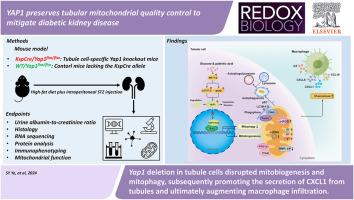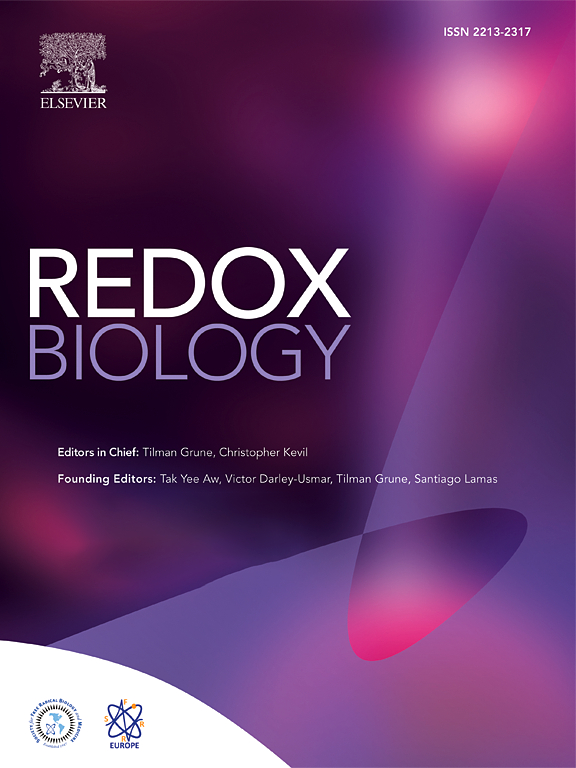YAP1 preserves tubular mitochondrial quality control to mitigate diabetic kidney disease
IF 10.7
1区 生物学
Q1 BIOCHEMISTRY & MOLECULAR BIOLOGY
引用次数: 0
Abstract
Renal tubule cells act as a primary site of injury in diabetic kidney disease (DKD), with dysfunctional mitochondrial quality control (MQC) closely associated with progressive kidney dysfunction in this context. Our investigation delves into the observed inactivation of yes-associated protein 1 (YAP1) and consequential dysregulation of MQC within renal tubule cells among DKD subjects through bioinformatic analysis of transcriptomics data from the Gene Expression Omnibus (GEO) dataset. Receiver operating characteristic curve analysis unequivocally underscores the robust diagnostic accuracy of YAP1 and MQC-related genes for DKD. Furthermore, we observed YAP1 inactivation, accompanied by perturbed MQC, within cultured tubule cells exposed to high glucose (HG) and palmitic acid (PA). This pattern was also evident in the tubulointerstitial compartment of kidney sections from biopsy-approved DKD patients. Additionally, renal tubule cell-specific Yap1 deletion exacerbated kidney injury in diabetic mice. Mechanistically, Yap1 deletion disrupted MQC, leading to mitochondrial aberrations in mitobiogenesis and mitophagy within tubule cells, ultimately culminating in histologic tubular injury. Notably, Yap1 deletion-induced renal tubule injury promoted the secretion of C-X-C motif chemokine ligand 1 (CXCL1), potentially augmenting M1 macrophage infiltration within the renal microenvironment. These multifaceted events were significantly ameliorated by administrating the YAP1 activator XMU-MP-1 in DKD mice. Consistently, bioinformatic analysis of transcriptomics data from the GEO dataset revealed a noteworthy upregulation of tubule cells-derived chemokine CXCL1 associated with macrophage infiltration among DKD patients. Crucially, overexpression of YAP1 via adenovirus transfection sustained mitochondrial membrane potential, mtDNA copy number, oxygen consumption rate, and activity of mitochondrial respiratory chain complex, but attenuated mitochondrial ROS production, thereby maintaining MQC and subsequently suppressing CXCL1 generation within cultured tubule cells exposed to HG and PA. Collectively, our study establishes a pivotal role of tubule YAP1 inactivation-mediated MQC dysfunction in driving DKD progression, at least in part, facilitated by promoting M1 macrophage polarization through a paracrine-dependent mechanism.

YAP1 保护肾小管线粒体质量控制,缓解糖尿病肾病
肾小管细胞是糖尿病肾病(DKD)的主要损伤部位,在这种情况下,线粒体质量控制(MQC)功能障碍与渐进性肾功能障碍密切相关。我们的研究通过对基因表达总库(GEO)数据集中的转录组学数据进行生物信息学分析,深入研究了在糖尿病肾病患者的肾小管细胞中观察到的 "是 "相关蛋白1(YAP1)失活及随之而来的MQC失调。接收者操作特征曲线分析明确强调了 YAP1 和 MQC 相关基因对 DKD 的诊断准确性。此外,在暴露于高葡萄糖(HG)和棕榈酸(PA)的培养小管细胞中,我们观察到 YAP1 失活,同时伴随着 MQC 的紊乱。这种模式在经活检批准的 DKD 患者肾脏切片的肾小管间质中也很明显。此外,肾小管细胞特异性 Yap1 缺失会加重糖尿病小鼠的肾损伤。从机理上讲,Yap1 基因缺失会破坏 MQC,导致肾小管细胞内线粒体有丝分裂和有丝分裂吞噬异常,最终导致组织学上的肾小管损伤。值得注意的是,Yap1 缺失诱导的肾小管损伤促进了 C-X-C motif 趋化因子配体 1(CXCL1)的分泌,可能会增加肾脏微环境中 M1 巨噬细胞的浸润。在 DKD 小鼠体内施用 YAP1 激活剂 XMU-MP-1 后,这些多方面的事件都得到了明显改善。同样,对来自 GEO 数据集的转录组学数据进行的生物信息学分析表明,在 DKD 患者中,与巨噬细胞浸润相关的肾小管细胞衍生趋化因子 CXCL1 的上调值得注意。重要的是,通过腺病毒转染过表达 YAP1 可维持线粒体膜电位、mtDNA 拷贝数、耗氧量和线粒体呼吸链复合物的活性,但会减少线粒体 ROS 的产生,从而维持 MQC,继而抑制暴露于 HG 和 PA 的培养肾小管细胞中 CXCL1 的生成。总之,我们的研究确定了肾小管 YAP1 失活介导的 MQC 功能障碍在推动 DKD 进展中的关键作用,至少部分作用是通过旁分泌依赖性机制促进 M1 巨噬细胞极化。
本文章由计算机程序翻译,如有差异,请以英文原文为准。
求助全文
约1分钟内获得全文
求助全文
来源期刊

Redox Biology
BIOCHEMISTRY & MOLECULAR BIOLOGY-
CiteScore
19.90
自引率
3.50%
发文量
318
审稿时长
25 days
期刊介绍:
Redox Biology is the official journal of the Society for Redox Biology and Medicine and the Society for Free Radical Research-Europe. It is also affiliated with the International Society for Free Radical Research (SFRRI). This journal serves as a platform for publishing pioneering research, innovative methods, and comprehensive review articles in the field of redox biology, encompassing both health and disease.
Redox Biology welcomes various forms of contributions, including research articles (short or full communications), methods, mini-reviews, and commentaries. Through its diverse range of published content, Redox Biology aims to foster advancements and insights in the understanding of redox biology and its implications.
 求助内容:
求助内容: 应助结果提醒方式:
应助结果提醒方式:


